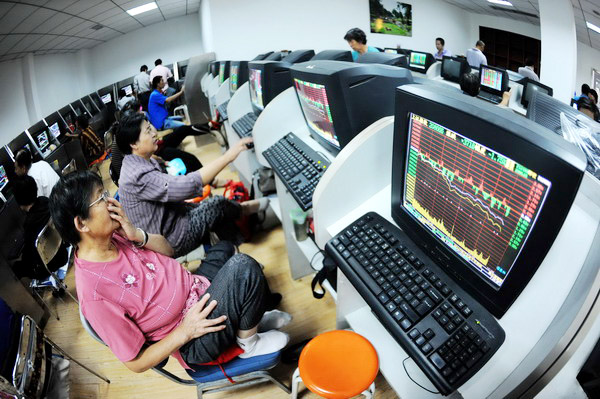Plan calls for further rate liberalization
Updated: 2012-09-18 09:11
By Wang Xiaotian (China Daily)
|
||||||||
Financial industry to contribute 5% of gross domestic product by 2015
China is aiming to make more market reforms to its financial system, according to a plan for the years 2011 to 2015.
Toward that end, it is seeking to further liberalize interest rates and exchange rates and make it easier for private holders of capital to enter the market, said a statement released on Monday by the People's Bank of China, the country's central bank.
In response, analysts said the plan lacks details, such as a schedule for certain important matters.
|
 Stock investors at a securities brokerage in Qingdao, Shandong province, on Monday. China's long-term financial reform plan (2011-15) covers all sectors of the financial industry, including the liberalization of interest rates and the stock market. [Photo/China Daily] |
The plan calls for an eventual liberalization of interest rates, aiming to achieve that goal by allowing the Shanghai Interbank Offered Rate, or Shibor, to play the dominant role in determining market interest rates.
The liberalization of the rates, it said, will be achieved through the "free pricing of alternative financial products". The plan also said various types of capital accounts will be opened up one by one - first those related to direct investments, then those concerning securities investment, and finally those related to lending, said Lu Zhengwei, chief economist at Industrial Bank Co Ltd.
"The biggest regret about this plan is that it has failed to give us a schedule or numerical target for the proposed reforms to the yuan's exchange rate and interest rate liberalization," Lu said.
The plan said China will set up a mechanism that will rely on market forces to directly determine the exchange rate of the yuan against emerging market currencies, and the yuan and those currencies will be traded in the interbank foreign exchange market.
The plan also calls for the establishment of a supervisory system to monitor the flow of domestic and foreign currencies across borders and for encouraging holders of private capital to set up rural banks and lending companies.
The government also promised to establish a procedure that will allow financial institutions to exit the Chinese market. And it called for the establishment of a deposit insurance system and the adoption of a bankruptcy law for financial institutions, but didn't give a schedule saying when those plans will be put into effect.
Pan Gongsheng, deputy governor of the People's Bank of China, said on Sunday that the country's financial reforms must be conducted in a way that conforms to the basic principles of commerce and the market system.
Authorities expect the financial industry will see its performance outpace the country's GDP from 2011 to 2015 and said the industry will be the source of 5 percent of China's total GDP, according to the plan.
The proportion of non-financial enterprises' direct financing to all kinds of financing is expected to increase to more than 15 percent by the end of the period, it said. At the end of 2011, the ratio had been 14 percent, up 9.1 percentage points from 2002.
Pan said it's difficult to make progress in plans to reform the financial system, which is still dominated by bank lending.
"The old ways of economic growth, that is, having the government constantly channel inexpensive capital ... to support massive investments, and thus spur the economy, were the source of many problems," he said.
wangxiaotian@chinadaily.com.cn

 Relief reaches isolated village
Relief reaches isolated village
 Rainfall poses new threats to quake-hit region
Rainfall poses new threats to quake-hit region
 Funerals begin for Boston bombing victims
Funerals begin for Boston bombing victims
 Quake takeaway from China's Air Force
Quake takeaway from China's Air Force
 Obama celebrates young inventors at science fair
Obama celebrates young inventors at science fair
 Earth Day marked around the world
Earth Day marked around the world
 Volunteer team helping students find sense of normalcy
Volunteer team helping students find sense of normalcy
 Ethnic groups quick to join rescue efforts
Ethnic groups quick to join rescue efforts
Most Viewed
Editor's Picks

|

|

|

|

|

|
Today's Top News
Health new priority for quake zone
Xi meets US top military officer
Japan's boats driven out of Diaoyu
China mulls online shopping legislation
Bird flu death toll rises to 22
Putin appoints new ambassador to China
Japanese ships blocked from Diaoyu Islands
Inspired by Guan, more Chinese pick up golf
US Weekly

|

|






